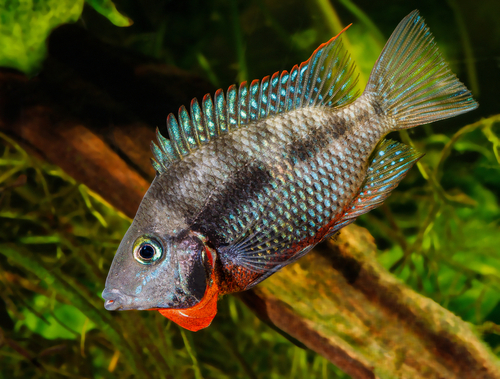When starting a community tank, the most important thing to keep in mind is compatibility. So if you’re starting out with firemouth cichlids and intend to diversify, you’ll need to consider a very important question – what fish are the best tank mates for firemouth cichlids?
The Firemouth Cichlid tank mates are fish of a similar size with fairly calm temperaments. Ideally, you’ll also want to choose fish that have similar environmental requirements, and offer the minimum amount of competition for resources.
Keep reading, and we’ll discuss the Top 12 Best Firemouth Cichlid tank mates.
Contents
Firemouth Cichlid Tank Mates – Basic Information You’ll Need:
Before you start looking for the best companions for your Firemouth Cichlid, you’ll want to know what kind of conditions are best for your Cichlid itself, and what sort of arrangement makes them happiest.
Temperament:
Generally speaking, Firemouth Cichlids are pretty friendly little fish. They’re not prone to starting fights or acting aggressively except under three conditions:
- Not enough room
- Tank conditions are too far from optimal
- Breeding season – males especially will get temperamental during this time
Size:
Female adult Firemouth Cichlids tend to be about 5 inches long.
Male adult Firemouth Cichlids tend to be about 6 inches long
Competition:
Firemouth Cichlids tend to prefer living in the middle of the tank, so any fish that prefer this region can be considered competitors for territory.
For food, they prefer crustaceans and high-protein foods, with the occasional vegetation. Fish with a similar diet can be considered competition for food resources.
Preferred Tank Setup and Water:
For the best tank arrangements, you’ll want to meet these basic requirements:
- Tank size: 30 gallons or more
- Water Ph Levels: 6.5 to 8.0
- Water Temperature: 75 to 86 degrees Fahrenheit
Firemouth Cichlids like sandy substrate, and plenty of hiding places. You’ll want a tank with plenty of plants, rocks and hiding places to make your Firemouth Cichlids as happy as possible.
The Best Firemouth Cichlid Tank Mates:
When it comes to the best tank mates for Firemouth Cichlids, these fish came out as the top contenders:
- Swordtails
- Rummy Nose Tetra
- Bristlenose Pleco
- Pictus Catfish
- Cory Catfish
- Rainbowfish
- Rosy Barb
- Convict Cichlid
- Clown Loach
- Clown Pleco
- Platies
- Salvini Cichlid
What makes these fish the best tank mates for Firemouth Cichlids?
You might also like:
1. Swordtails
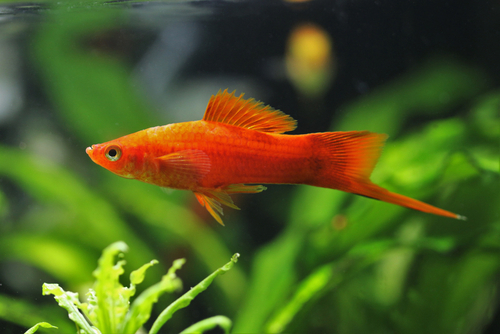
- Scientific Name: Xiphophorus helleri
- Adult Size: 4 to 5 inches
- Preferred Tank Mates: Firemouth Cichlids, Platies, Rosy Barbs, Cory Catfish, Neon Tetras
- Optimal Temperature: 65 to 82 degrees Fahrenheit
- Minimum Tank Size: 30 gallons (for more than one)
- Difficulty of Care: Easy
- Origin: North America and Central America
These fish are peaceful and relatively easy to care for, and have a striking appearance due to the ‘sword’ that gives them their name. However, their main selling point, aside from their temperament, is that they come from the same region as firemouth teras, so their environmental requirements are almost identical.
Pros/Cons:
| Peaceful and easy-going | Young fish may become targets for Firemouths |
| Omnivores that will eat anything | Require a more varied diet than Firemouths |
| Can inhabit any area of the tank at any depth | May wind up competing with Firemouths for territory |
2. Rummy Nose Tetras
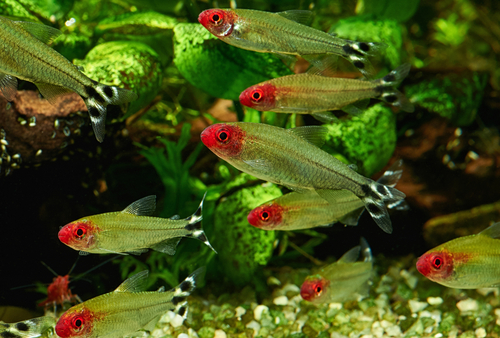
- Scientific Name: Hemigrammus rhodostomus
- Adult Size: 2 to 3 inches
- Preferred Tank Mates: Firemouth Cichlids, Green Neon Tetras, Pearl Gourami, Corydoras Catfish
- Optimal Temperature: 75 to 84 degrees Fahrenheit
- Minimum Tank Size: 20 gallons
- Difficulty of Care: Moderate
- Origin: Amazon Basin
These small and lively fish are known for their quiet temper and vibrant coloring, and make an ideal tank mate due to their ease in coexisting. Even if they encounter a tempermental Firemouth, they’re capable of escaping as long as they have plenty of hiding spaces.
Pros/Cons:
| Peaceful and social temperament | Require a community of 6 or more to be happy |
| Don’t need a lot of space | Sensitive to water condition, require closer monitoring |
| Prefer vegetarian diet – no competition for food | Requires a more varied diet |
3. Bristlenose Pleco
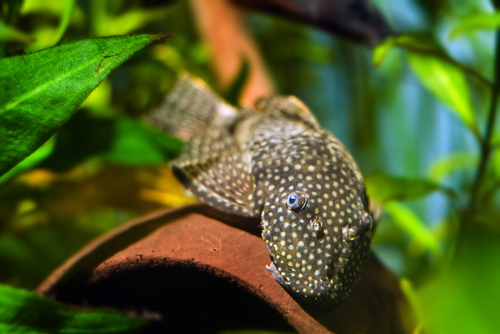
- Scientific Name: Ancistro Cirrhosus
- Adult Size: Up to 5 inches
- Preferred Tank Mates: Firemouth Cichlids, Neon Tetras, Platies, Guppies
- Optimal Temperature: 60 to 80 degrees Fahrenheit
- Minimum Tank Size: 25 gallons (more in community tanks)
- Difficulty of Care: Beginner
- Origin: Central and South America
These bottom feeding algae eaters are excellent tank mates for a Firemouth. They don’t compete for territory or food, and they have an armored hide that can handle even the most temperamental Firemouth.
Pros/Cons:
| Very efficient at cleaning tanks and scavenging | Nocturnal and shy – not often seen |
| No competition for food – herbivores | Need plenty of algae and supplements |
4. Pictus Catfish
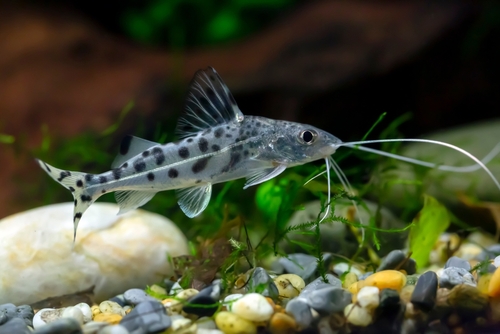
- Scientific Name: Pimelodus pictus
- Adult Size: About 5 inches
- Preferred Tank Mates: Firemouth Cichlids, Giant Danios, Rainbow Sharks, Opaline Gourami
- Optimal Temperature: 70 to 80 degrees Fahrenheit
- Minimum Tank Size: About 55 gallons
- Difficulty of Care: Fairly Easy
- Origin: South America
These peaceful and calm fish make excellent tank mates for Firemouths. They prefer the bottom of the tank, so they won’t fight for their territory, though there may be some squabbling over food resources.
Pros/Cons:
| Carnivorous – easy to feed | May be competition for food |
| Easy-going and even tempered | Requires more space for swimming |
| Bottom-dwelling – no territorial issues | May eat Firemouth fry during breeding |
5. Cory Catfish
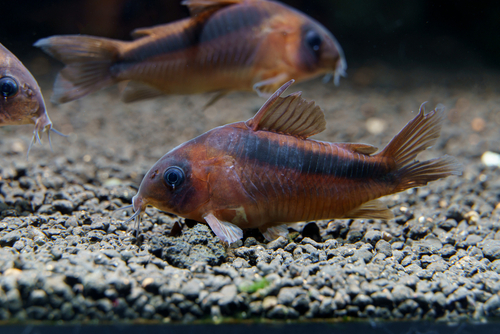
- Scientific Name: Corydoras (second name depends on specific breed)
- Adult Size: 1 to 4 inches
- Preferred Tank Mates: Firemouth Cichlids, Platies, Guppies, Neon Tetras, Swordtails
- Optimal Temperature: 70 to 80 degrees Fahrenheit
- Minimum Tank Size: 20 to 30 gallons recommended
- Difficulty of Care: Easy
- Origin: South America
With over 165 breeds of Corydora catfish, there’s no shortage of unique and brightly colored fish to choose for your tank. And as peaceful bottom dwellers, any of these breeds is capable of coexisting comfortably with your Firemouth Cichlids
Pros/Cons:
| Pleasant temperament and social fish | Require a school of multiple fish to be truly happy |
| Scavengers – and omnivores | May be competition for food |
| Good at defending themselves while being non-aggresive |
6. Rainbowfish
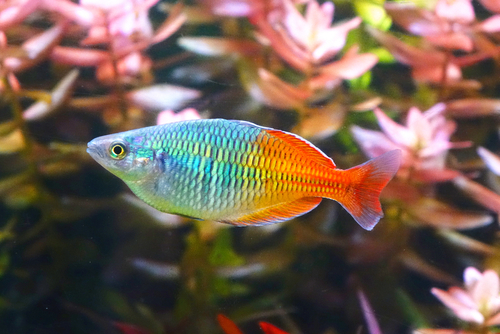
- Scientific Name: Melanotaeniidae boesemani
- Adult Size: About 4 to 5 inches
- Preferred Tank Mates:
- Optimal Temperature: 81 to 86 degrees Fahrenheit
- Minimum Tank Size: 30 gallons
- Difficulty of Care: Easy
- Origin: Australia and Asia
These brightly colored fish are fun to watch. They’re also incredibly non-confrontational, which makes them excellent tan mates for Firemouth Cichlids.
Even if provoked, these fascinating little fish are likely to hide rather than fight, and can escape even the most touchy Firemouth
Pros/Cons:
| Easy to feed – they’re omnivores | May wind up competing for food |
| Peaceful and friendly with calm temperaments | Prefer schools – need 5 or six for happy rainbowfish |
| Adaptable and comfortable in warmer water for Firemouths |
7. Rosy Barb
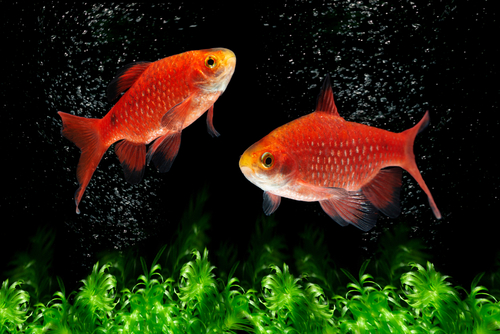
- Scientific Name: Puntius conchonius
- Adult Size: 5 to 6 inches
- Preferred Tank Mates: Firemouth Cichlids, Neon Tetra, Swordtails, Cherry Barb
- Optimal Temperature: 64 to 79 degrees Fahrenheit
- Minimum Tank Size: 20 gallons
- Difficulty of Care: Fairly Easy
- Origin: South Asia
These fish will add a bright spot of color to your tank, and they do well with Firemouths. They aren’t as placid as some other ideal tank mates, but their nature allows them to live in harmony, since they’re willing to defend themselves if needed
Pros/Cons:
| Omnivores – they’ll eat just about anything | May become competitors for food and territory |
| Active and love to swim around and explore | You’ll need to make sure you have plenty of vegetation to occupy them |
8. Convict Cichlid
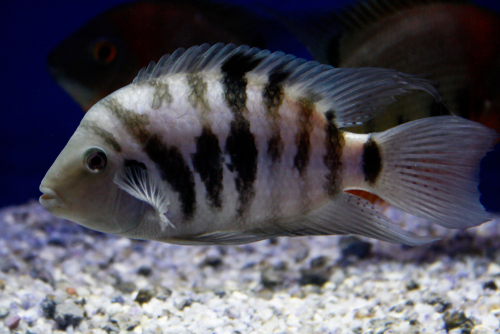
- Scientific Name: Amatitlania nigrofasciata
- Adult Size: 4 to 5 inches
- Preferred Tank Mates: Firemouth Cichlids,
- Optimal Temperature: 79 to 84 degrees Fahrenheit
- Minimum Tank Size: 30 gallons
- Difficulty of Care: Moderate
- Origin: Central America
These eye-catching fish are named for the stripes on their sides, and they make excellent tankmates for the Firemouth Cichlid, despite their feisty nature. However, as long as there’s plenty of room to play and establish separate territories, there’s no reason these two Cichlid species can’t get along.
Pros/Cons:
| Active temperament and fun to watch | Can become aggressive if not given enough space. |
| Omnivores – will eat just about anything | May become competitors for food |
9. Clown Loach
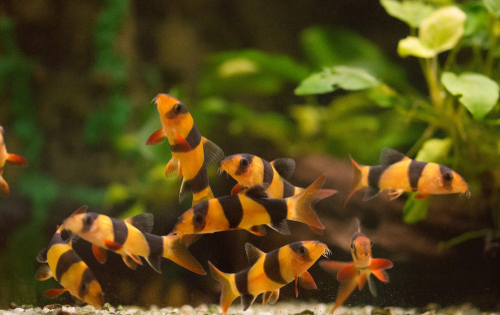
- Scientific Name: Chromobotia macracanthus
- Adult Size: About 12 inches
- Preferred Tank Mates: Firemouth Cichlids, Bristlenose Pleco, Neon Tetra, Cherry Barb
- Optimal Temperature: 72 to 86 degrees Fahrenheit
- Minimum Tank Size: 75 to 150 gallons
- Difficulty of Care: Easy
- Origin: Southeast Asia
These fish are peaceful bottom dwellers, guaranteed to add a spot of color to your aquarium. They’re a good choice in terms of temperament and territory, but you’ll need to have plenty of space, as these fish are much larger than the others on this list.
Pros/Cons:
| Peaceful and easy-going fish | Needs much more room, especially if you have more than one |
| Bottom dwelling – no territory competition. | May be competition for food |
| Omnivores – they’ll eat most foods |
10. Clown Pleco
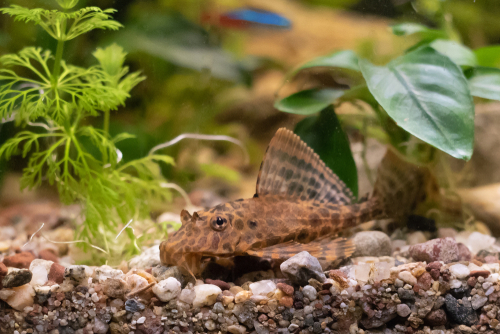
- Scientific Name: Panaque maccus
- Adult Size: 3 to 4 inches
- Preferred Tank Mates: Firemouth Cichlids, Cory Catfish, Ember Tetras, Rasboras, Dwarf Gourami
- Optimal Temperature: 73 to 82 degrees Fahrenheit
- Minimum Tank Size: 20 gallons
- Difficulty of Care: Easy to Moderate
- Origin: Venezuela and Columbia
These elegant and relatively placid bottom dwelling fish will be happy to clean up your tank. They’re unlikely to compete with your Firemouths over territory food, and they’re good at hiding from temperamental fish.
Pros/Cons:
| Herbivores – no competition for food | Need plenty of driftwood to thrive |
| Bottom dwelling – no territory competition | Need to keep an eye on the water conditions |
11. Platies
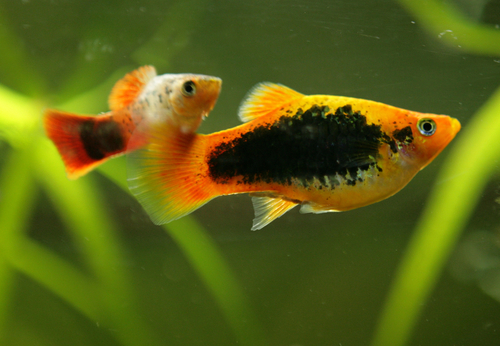
- Scientific Name: Xiphophorus (last name depends on particular species
- Adult Size: 2 to 3 inches
- Preferred Tank Mates: Firemouth Cichlids, Cory Catfish, Swordtails, Cardinal Tetra
- Optimal Temperature: 65 to 82 degrees Fahrenheit
- Minimum Tank Size: 10 gallons
- Difficulty of Care: Easy
- Origin: Central America
There are several different types of platies, but they’re all known for being easy to care for and easy going in terms of nature. If you’re a beginner, you won’t find an easier type of fish to integrate with your Firemouth Cichlids
Pros/Cons:
| Easy-going and easy to care for | Need to make sure you have the proper ratio of males to females |
| Omnivores – they’ll eat almost anything | May become competition for food |
| Community fish – get along with almost all other species |
12. Salvini Cichlid
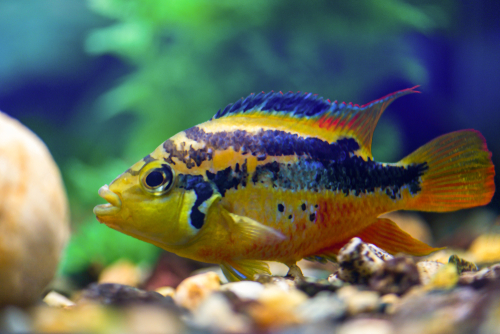
- Scientific Name: Nandopsis salvini
- Adult Size: Up to 7 inches
- Preferred Tank Mates: Firemouth Cichlids, Plecos, Convict Cichlids, Oscar fish
- Optimal Temperature: 75 to 79 degrees Fahrenheit
- Minimum Tank Size: 40 to 55 gallons
- Difficulty of Care: Easy to Moderate
- Origin: Central America
These fish are colorful cousins to the Firemouth Cichlid, and come in a variety of hues. They’re active and fun to watch, with a personality to match, but you’ll need to make sure they have plenty of room if you want to avoid territorial issues between these two Cichlid types
Pros/Cons:
| Interesting personality, fun to watch | Territorial – needs more room if housed with Firemouths |
| Easy to feed – omnivores | May be competition for food |
Final Thoughts:
If you’re looking for tank mates to help give your Firemouth Cichlids a community aquarium, this list should provide you a good place to start. From here, it’s all about finding the fish that suits you and your aquarium best.

Ian Sterling, founder of Fishlab.com, began his aquarium journey over 30 years ago, driven by a deep fascination for fish and their diverse personalities. His website, Fishlab.com, is dedicated to making fishkeeping accessible and enjoyable, offering beginner-friendly guidance, expert insights, and a community for aquarists to connect and share experiences.


